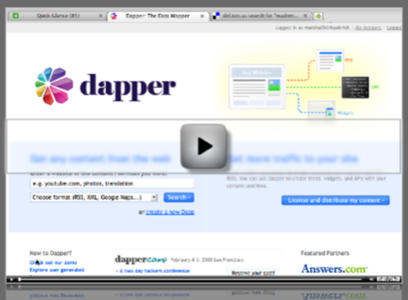The invention of the browser was a huge boon to the internet and a substantial amount of computing now goes on through that interface we’ve grown to love. The internet is not a place where innovation takes a break, though, and a new generation of applications are emerging that have a different relationship with the web browser.

From taking control of the browser to connecting to the web outside of it, there are a number of new strategies being implemented by startups these days. In the following post we discuss seven different ways that new apps are telling browsers “you ‘aint the boss of me now!” Some you’ll be familiar with, but some you may not be.
If you’d like to discuss any of the following examples in real time with other readers, and see where their mouses are going on the page while you’re reading, click on the button below. Details about this at the end of the article!
Offline Syncing
Web connectivity is approaching ubiquity for urban web users in the developed world, but there are a number of reasons that off-line access to web content is gaining momentum. Wireless coverage is often spotty, EVDO is expensive and often under-performs, air travel requires working offline for now and it’s just nice to have a local copy of content that you can use without going online.
Google Gears is the best known way that apps are going offline and it’s not just Google apps that use the platform to download content and sync back up when connectivity returns. Web office Zoho offers Gears support for offline use of its tools, for example, as does the handsome mind mapping tool MindMeister. Google Gears also has a mobile component. Some apps at least have had initial problems with the fidelity of the syncs back online – syncing anything is hard.
Here’s an hour-long nerd-a-thon from last month, titled “What’s New in Google Gears.” If you’re interested in a detailed status check on Gears, this is a fun little video to watch.
It’s not just Google doing offline synching. Application development framework Etelos recently rolled out the capability to take any app offline, including enterprise installs of Google Apps, MediaWiki and WordPress.
The new Firefox 3 is also offering offline support for web apps in general, though the apps will need to be re-engineered in order for this to be truly viable. Firefox 3 is still in beta, but I use the current version exclusively and it’s great on a Mac. Zimbra is available using Firefox’s early offline support, you can read about the newest developments here.
Sometimes, though, it’s good when you’re offline to just be alone with your thoughts for awhile, or pay attention to your non-electronic surroundings.
Rich Internet Apps – RIAs
Rich Internet Apps are applications that run on the desktop, outside of the browser, but utilize web connectivity for sending and recieving information. They’ve got the speed and responsiveness of a desktop app, combined with the read/write capabilities of a web app.
Adobe’s AIR platform is the most popular system for building consumer level RIAs so far and there are some really beautiful ones available allready. In addition to the best Twitter clients (AIR apps like Twhirl, Snitter and Spaz there are also many other applications being developed as RIAs. Check out the very cool directory site FreshAIR Apps for a taste of what else is being done in this space.
Adobe’s Thermo is a show stealer.
If you’re interested in a deep dive into the world of RIAs, check out Redmonk’s podcast series RIA Weekly.
Single App Browsers
Site specific browsers are a new direction being explored by a company called Fluid. Why would you want a single app browser? It’s nice to be able to work with a particular application outside of your primary browser, just for ease of use, but there are even more reasons than that. Fluid allows a high degree of customization, including easy implementation of Greasemonkey user scripts. Check out the screencast video below.
from
on
.
I use a Fluid version of social music site Muxtape daily and just now began fantazising about putting Google Reader in its own Single App Browser.
Screencasting/sharing
Few things combine “wow” factor with utility as much as a good screensharing app. While there are a number of good paid options (Webex and Adobe Breeze) there are also a growing number of free ways to show someone else your desktop or look at theirs. While most screensharing apps require both parties to download a desktop client, one popular alternative is Yuuguu. This app lets the viewing party use a tab in their browser to watch the presenting party’s desktop. It’s really easy to use and is great for providing tech support or tutorials.
Presenter downloads are available for Windows and for Mac. I’ve had one problem broadcasting to a viewer using Windows, but generally speaking it’s worked great.
Greasemonkey
Greasemonkey is an easy way to add all kinds of functionality to existing web pages by adding simple javascript plug-ins to your Firefox browser. It takes five minutes and zero technical skills to use. First install Greasemonkey, then peruse a world of plug-in options. There are hundreds of scripts to chose from at Userscripts.org but our own Sarah Perez highlighted a list of some of the best for heavy social media users earlier this month. Unfortunately some of those scripts don’t seem to work with the new Firefox 3 yet. See also the fabulous Gina Trapani’s collection of Gmail scripts called Better Gmail. I just used it to add a number of new features to Gmail and am quite happy about it. See also GMail Redesigned, which isn’t Greasemonkey – it’s just using the browser’s own CSS options to redesign GMail. That looks even better.
Check out this very, very charming video about “fixing the web with Greasemonkey.” It’s pretty cool.
Total Browser Pwnage
Firefly
The above apps are cool, but there’s a whole other level of control that some new apps give you over the browser. We eagerly anticipate seeing more apps like the following.
What is this strange orange haze that many of you have been reading this post through? If you hadn’t above you can open fireflywith this link. (RSS readers can click through to check this out) It’s a simple little app called Firefly. First demonstrated by on Dave Winer’s Scripting.com, it’s a handy little bit of javascript that creates an interesting social browsing and chat experience.
Iterasi
Iterasi (disclosure: consulting client) is a plug-in that captures the exact content of a browser at a given moment in time, including AJAX states and forms. The saved content is then stashed in a personal online archive that can be searched inside of, shared with other people by email or embedded in a blog post.
While it’s Windows only right now, as soon as there’s a Mac version I look forward to using it to save legal forms online, company Terms of Service and many other kinds of web content. Give this embed below a click and see how it works.
Since I’m closer to this one than to many of the other apps here I can tell you it doesn’t work as well yet as I wish it did, but it’s coming along and has great potential. I regularly find myself wishing the Mac version was done so I could capture a page on a site with a click.
Dapper
Dapper is another web app that pushes the limits of the browser. It allows you to click to select any field on a web page and monitor that particular field for changes. Changes are delivered by RSS. The possibilities are endless.

The company has a number of other data outputs available, but almost all of them are broken and not worth trying to use. The company has recently struggled with some uptime issues as well. When it works and your needs are technically simple, Dapper can make web pages do back flips for you.
Conclusion
All of the above have their shortcomings but they all also offer a new world of functionality, they open a new horizon beyond the limitations of loading and reading and writing single web pages at a time.
These are some of our favorite post-browser apps, what are some of yours? We’d love to learn more about the bleeding edge of this kind of strategy. These are really fun and useful ways to use our computers.
Rainbow image by Cessna 206










